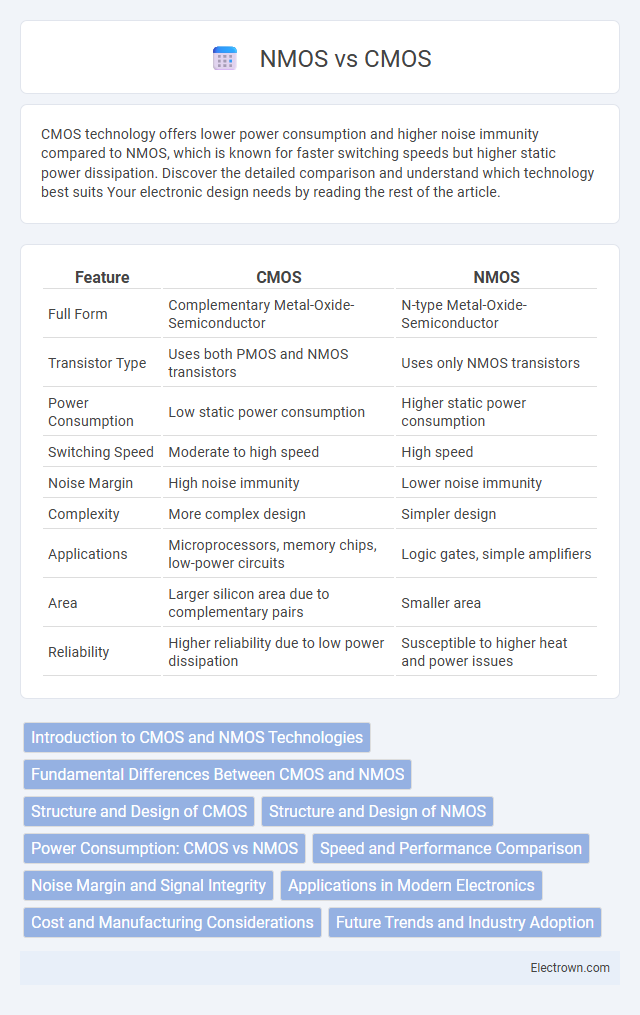CMOS technology offers lower power consumption and higher noise immunity compared to NMOS, which is known for faster switching speeds but higher static power dissipation. Discover the detailed comparison and understand which technology best suits Your electronic design needs by reading the rest of the article.
Table of Comparison
| Feature | CMOS | NMOS |
|---|---|---|
| Full Form | Complementary Metal-Oxide-Semiconductor | N-type Metal-Oxide-Semiconductor |
| Transistor Type | Uses both PMOS and NMOS transistors | Uses only NMOS transistors |
| Power Consumption | Low static power consumption | Higher static power consumption |
| Switching Speed | Moderate to high speed | High speed |
| Noise Margin | High noise immunity | Lower noise immunity |
| Complexity | More complex design | Simpler design |
| Applications | Microprocessors, memory chips, low-power circuits | Logic gates, simple amplifiers |
| Area | Larger silicon area due to complementary pairs | Smaller area |
| Reliability | Higher reliability due to low power dissipation | Susceptible to higher heat and power issues |
Introduction to CMOS and NMOS Technologies
CMOS (Complementary Metal-Oxide-Semiconductor) technology uses both p-type and n-type MOSFETs to achieve low power consumption and high noise immunity in digital circuits. NMOS (N-type Metal-Oxide-Semiconductor) technology relies solely on n-type transistors, providing faster switching speeds but higher power dissipation. Your choice between CMOS and NMOS impacts device performance, power efficiency, and manufacturing complexity in integrated circuit design.
Fundamental Differences Between CMOS and NMOS
CMOS (Complementary Metal-Oxide-Semiconductor) technology uses both NMOS and PMOS transistors to achieve low power consumption and high noise immunity, whereas NMOS technology utilizes only NMOS transistors, resulting in higher power dissipation. CMOS circuits primarily operate by switching complementary transistors on and off, reducing static power draw, while NMOS circuits rely on charge depletion in pull-down networks, increasing static power consumption. The fundamental difference lies in CMOS's complementary transistor pairing for efficient switching compared to NMOS's single transistor type approach.
Structure and Design of CMOS
CMOS (Complementary Metal-Oxide-Semiconductor) technology integrates both NMOS and PMOS transistors in a single circuit, utilizing complementary pairs to achieve low power consumption and high noise immunity. The CMOS structure consists of p-type wells housing NMOS transistors and n-type wells containing PMOS transistors, arranged on a silicon substrate with isolation by shallow trench isolation (STI) techniques. Designing CMOS circuits involves careful layout of these transistors to minimize capacitance and delay, optimizing power efficiency and switching performance compared to standalone NMOS designs.
Structure and Design of NMOS
NMOS transistors feature an n-type semiconductor channel between the source and drain, controlled by a positively charged gate electrode insulated by a thin oxide layer. The design of NMOS devices emphasizes faster electron mobility, enabling higher switching speeds compared to PMOS counterparts. You can optimize circuit performance by leveraging the simpler structure and lower fabrication complexity inherent in NMOS technology.
Power Consumption: CMOS vs NMOS
CMOS technology significantly reduces power consumption compared to NMOS by using complementary pairs of p-type and n-type MOSFETs that only draw current during switching events. NMOS circuits consume continuous static power as the transistor remains partially on, leading to higher heat dissipation and energy waste. Your designs benefit from CMOS integration when minimizing power usage is critical, especially in battery-powered and large-scale applications.
Speed and Performance Comparison
NMOS transistors offer faster switching speeds due to higher electron mobility compared to CMOS, which combines both NMOS and PMOS transistors. CMOS technology excels in power efficiency, but its speed is often limited by the slower hole mobility in PMOS devices. Your choice between CMOS and NMOS depends on whether raw speed or balanced power-performance is more critical for your application.
Noise Margin and Signal Integrity
CMOS technology offers superior noise margin compared to NMOS due to its complementary transistor configuration, which provides better voltage level stability and reduced susceptibility to noise. Signal integrity is enhanced in CMOS circuits as they consume less power and generate less heat, minimizing voltage fluctuations and signal degradation. NMOS devices, while faster in switching, typically exhibit lower noise margins and higher vulnerability to signal integrity issues because of their unipolar transistor design.
Applications in Modern Electronics
CMOS technology dominates modern electronics due to its low power consumption and high noise immunity, making it ideal for microprocessors, memory chips, and digital logic circuits. NMOS circuits, while faster and simpler, are often used in specialized applications such as analog signal processing and RF circuits where speed is critical. The integration of CMOS in smartphones, laptops, and IoT devices underscores its versatility and energy efficiency compared to NMOS-based designs.
Cost and Manufacturing Considerations
CMOS technology offers lower power consumption and higher density, making it more cost-effective for large-scale integrated circuits despite its slightly complex manufacturing process compared to NMOS. NMOS devices have simpler fabrication steps, potentially reducing initial manufacturing costs but often result in higher power dissipation and less efficient scaling. Your choice between CMOS and NMOS should weigh long-term production efficiency and performance demands against upfront manufacturing expenses.
Future Trends and Industry Adoption
CMOS technology continues to dominate the semiconductor industry due to its low power consumption and high noise immunity, driving its adoption in advanced applications like AI processors and IoT devices. NMOS devices, while offering faster switching speeds, face challenges in power efficiency, limiting their use primarily to niche high-speed circuits and certain analog applications. Emerging trends emphasize the integration of CMOS with novel materials and 3D chip architectures to enhance performance and energy efficiency, ensuring CMOS remains the preferred choice for future semiconductor innovation.
CMOS vs NMOS Infographic

 electrown.com
electrown.com